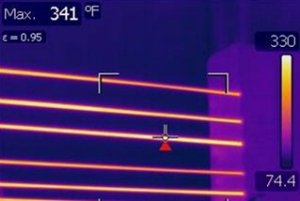Automated Condition Monitoring
Thermal imaging fulfils a crucial need in automation and condition monitoring across many sectors. Using the power of infrared technology, businesses will detect and respond to issues more accurately, ensuring safe, efficient operations. This also enables faster and even fully automated decision-making for essential areas such as fire safety, where every second wasted will harm your business.
Constant Thermal Monitoring
Automated condition monitoring helps avert costly setbacks that might impede production. By embracing the benefits of automated inspections, site managers will monitor their operations continuously and detect anomalies that may lead to dangerous situations. For example, in an industrial environment, constant monitoring using thermal cameras negates the need for regular manual inspections by an engineer. Instead, it enables automated alert mechanisms triggered when temperatures hit certain levels.
Automated Thermal Imaging Real-World Applications:
Thermascan is proud to bring an array of top-tier thermal imaging cameras for hire or sale across the UK. Our offerings include high-end models designed for unmatched accuracy and precision and specialised cameras optimised for automation and condition monitoring.
Flare Stacks and Electrical Substations: with thermal cameras, any heat build-up due to malfunction in electrical and mechanical installations is quickly detected. This ability is critically important in environments such as electrical substations and flare stacks where early detection of problems can avoid major failures and accidents.
Steel Mill Ladles and Warehouses: these areas are characterised by high temperatures and potential fire hazards. Automated thermal imaging protects warehouses by providing critical data and insights about temperature changes that could lead to stock destruction. For mills, similar data is acted upon to prevent accidents during operations and ensure worker safety.
Combustible Piles Waste Facility Monitoring: in combustion pile monitoring and general waste management, the consequences of overheating can be disastrous, and thermal imaging is used for safety monitoring. It provides real-time monitoring and early warning of any potential risks, enabling to take quick action.
Automotive Manufacturing, Food Processing and Packaging: automated thermal imaging is an integral part of these industries for quality control. Thermal imaging in the automotive industry surveys assess vehicles in operation, detecting any undesired friction that can indicate quick-wearing parts. In the food industry, thermal imaging cameras monitor production and packaging lines for temperature consistency, ensuring perishable goods' suitability for consumption and the perfection of heat-sealed packaging.
High-Quality Cameras for Automated Condition Monitoring
Our thermal imaging technology can pinpoint even the most minor temperature variations, helping you discern potential issues and uphold optimal performance across various applications. To explore a thermal monitoring solution that can serve you best, feel free to contact us at any time.
Teledyne FLIR Camera Automated Applications
Process control
Condition monitoring
Quality control
Get in Touch for More Information About The Automated Applications of Thermal Imaging Cameras:
Automated Thermal Imaging FAQs
-
When automated, a thermal imaging camera identifies equipment failures or breakdowns, permitting remote monitoring and effective control.
-
Automated condition monitoring helps avert costly setbacks that might impede production. It enables continuous monitoring and detects anomalies that may lead to dangerous situations.
-
In an industrial environment, constant monitoring using thermal cameras negates the need for regular manual inspections by an engineer. Instead, it enables automated alert mechanisms triggered when temperatures hit certain levels.
-
Yes, the use of thermal imaging extends beyond spotting potential problems. These cameras are extensively used for quality control across industries, whether it is monitoring the product itself or using thermal imaging for packaging inspections.
-







